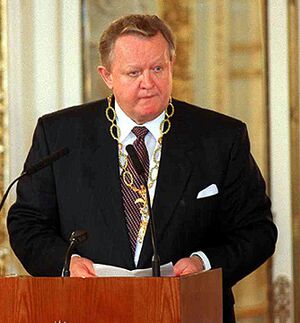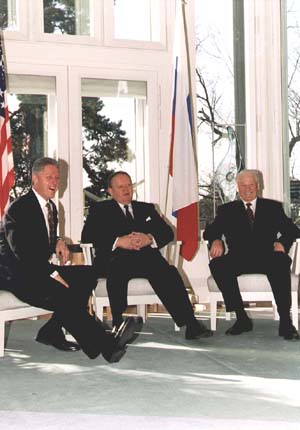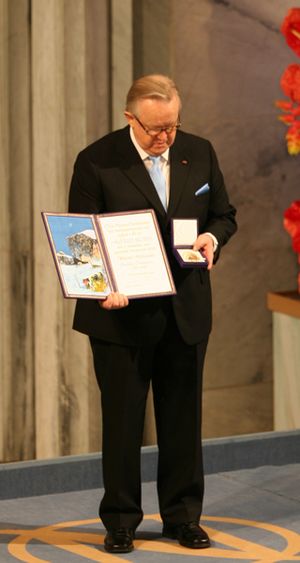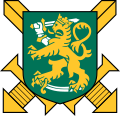Martti Ahtisaari facts for kids
Quick facts for kids
Martti Ahtisaari
|
|
|---|---|
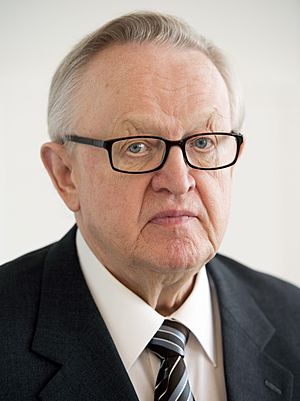
Ahtisaari in 2012
|
|
| 10th President of Finland | |
| In office 1 March 1994 – 1 March 2000 |
|
| Prime Minister | Esko Aho Paavo Lipponen |
| Preceded by | Mauno Koivisto |
| Succeeded by | Tarja Halonen |
| Ambassador of Finland to Tanzania | |
| In office 1973–1977 |
|
| Preceded by | Seppo Pietinen |
| Succeeded by | Richard Müller |
| Personal details | |
| Born | 23 June 1937 Viipuri, Finland (now Vyborg, Russia) |
| Died | 16 October 2023 (aged 86) |
| Political party | Social Democratic |
| Spouse | Eeva Hyvärinen |
| Children | Marko Ahtisaari |
| Alma mater | University of Oulu |
| Awards | Nobel Peace Prize (2008) |
| Signature | |
| Military service | |
| Branch/service | |
| Rank | |
Martti Oiva Kalevi Ahtisaari (born 23 June 1937 – died 16 October 2023) was an important Finnish leader. He was the tenth President of Finland from 1994 to 2000. He also won the Nobel Peace Prize because he worked hard to bring peace to different parts of the world. He was a diplomat and mediator for the United Nations, helping to solve big problems between countries.
Ahtisaari was a special helper for the United Nations in Kosovo. He helped organize talks to solve a long-standing disagreement there. Kosovo later became independent from Serbia in 2008. In October 2008, he received the Nobel Peace Prize. The award was for his efforts over more than 30 years to solve international conflicts. The Nobel committee said he played a big part in ending serious conflicts in places like Namibia, Aceh (in Indonesia), Kosovo, Serbia, and Iraq.
Contents
Early Life and First Jobs
Martti Ahtisaari was born in Viipuri, Finland. This city is now called Vyborg and is in Russia. During World War II, his father was a mechanic in the army. His mother, Tyyne, moved with Martti to Kuopio to stay safe from the war. Martti spent most of his childhood in Kuopio and went to high school there.
In 1952, Martti Ahtisaari moved to Oulu with his family. He finished high school in Oulu in 1956. He also joined the local YMCA. After serving in the Finnish Army (where he became a captain), he studied to become a primary school teacher. He finished his teaching course in 1959. Besides Finnish, Martti Ahtisaari could speak Swedish, French, English, and German.
In 1960, he went to Karachi, Pakistan. He led a physical education training center there. This job helped him get used to working in an international setting. He returned to Finland in 1963. He started working with groups that help developing countries. In 1965, he joined Finland's Ministry for Foreign Affairs. He worked in the department that gave aid to other countries. In 1968, he married Eeva Irmeli Hyvärinen. They had one son, Marko Ahtisaari.
Working as a Diplomat
Martti Ahtisaari spent many years representing Finland as a diplomat. From 1973 to 1977, he was Finland's Ambassador to Tanzania. He also worked for the United Nations from 1977 to 1981. He helped Namibia become independent from South Africa.
From 1987 to 1991, Ahtisaari was in charge of administration and management for the United Nations. In 1989, he went to Namibia as a special representative for the UN. He led the United Nations Transition Assistance Group (UNTAG). This group helped Namibia prepare for its independence.
After Namibia's independence elections in 1989, Ahtisaari became an honorary citizen of Namibia. South Africa also gave him an award for his work as a diplomat. The award recognized his dedication to freedom in Africa and peace around the world.
President of Finland
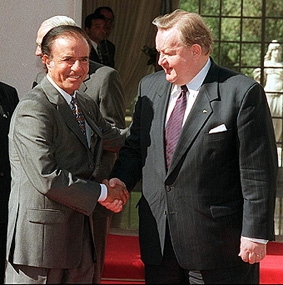
Martti Ahtisaari decided to run for president of Finland. At the time, Finland was going through a tough economic period. Many people were unhappy with the politicians already in power. In 1993, Ahtisaari became the candidate for the Social Democratic Party. People liked that he had a clean image and wanted Finland to be more active in world affairs. He won the election against Elisabeth Rehn.
His time as president started with some challenges. The prime minister, Esko Aho, did not always agree with Ahtisaari's active role in foreign policy. Ahtisaari also spoke out about issues in Finland, like unemployment. He traveled a lot both in Finland and to other countries. People nicknamed him "Travel-Mara" because he traveled so much. He visited one Finnish province every month, which made him very popular. He also gave money to groups that helped unemployed people.
President Ahtisaari believed in different religions and ideas living together peacefully. He and his wife were Christian. He often ended his New Year's speeches by asking for God's blessing for the Finnish people.
President Ahtisaari strongly supported Finland joining the European Union. In 1994, 57 percent of Finnish voters agreed to join the EU. He later said he would have resigned if Finland had not voted to join. During his presidency, Boris Yeltsin and Bill Clinton met in Helsinki. Ahtisaari also worked with Viktor Chernomyrdin to help end the fighting in Kosovo in 1999.
Ahtisaari did not run for re-election in 2000. He was the last "strong president" before Finland's constitution changed. The new constitution gave the president less power. Tarja Halonen, who was the foreign minister, became the next president.
After Being President

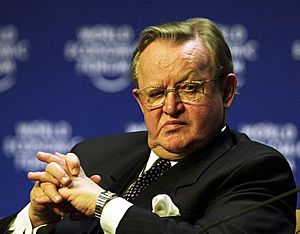
After leaving office, Ahtisaari worked with many international groups. In 2000, he became the head of the International Crisis Group. This group works to prevent and solve conflicts around the world. He also started his own group, the Crisis Management Initiative (CMI). Its goal is to build and keep peace in troubled areas.
In 2000 and 2001, Ahtisaari helped check on weapons in Northern Ireland as part of the peace process there. In 2005, he successfully led peace talks between the Free Aceh Movement and the Indonesian government. These talks ended with an agreement in August 2005.
In November 2005, the UN Secretary-General asked Ahtisaari to be a special helper for Kosovo. His job was to decide if Kosovo should become independent or stay part of Serbia. He worked from an office in Vienna, Austria, to lead these talks. Kosovo later declared its independence in February 2008.
Ahtisaari always said that the United States was very important for peace. He believed that "There can be no peace without America." From 2000 to 2009, he was the chairman of the Interpeace Governing Council. In September 2009, Ahtisaari joined The Elders. This is a group of global leaders who work for peace and human rights.
Health
On 24 March 2020, it was announced that Ahtisaari had tested positive for COVID-19. His wife, Eeva Ahtisaari, also had the virus. They both recovered by April 2020. On 2 September 2021, it was announced that Ahtisaari was suffering from Alzheimer's disease. He then retired from public life. Martti Ahtisaari passed away on 16 October 2023, at the age of 86.
Awards and Honours
Nobel Peace Prize
On 10 October 2008, Martti Ahtisaari was awarded the Nobel Peace Prize. He received the prize in Oslo, Norway, on 10 December 2008. The Nobel committee recognized his work in Kosovo, first in 1999 and again from 2005 to 2007. They also noted his efforts to find peaceful solutions in Iraq, Northern Ireland, Central Asia, and the Horn of Africa.
| Coat of Arms of Martti Ahtisaari | |
|---|---|
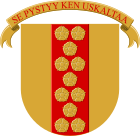 |
|
| Armiger | Martti Ahtisaari |
| Adopted | 1994 |
| Motto | Se pystyy ken uskaltaa ("The one who dares, can") |
Other Awards
- 1995: Zamenhof Prize for International Understanding
- 2000: J. William Fulbright Prize for International Understanding
- 2000: Freedom medal
- 2004: OR Tambo Award
- 2008: Félix Houphouët-Boigny Peace Prize
- 2008: Geuzenpenning
Images for kids
-
Ahtisaari (first from left) with William Hague, Jimmy Carter, and Lakhdar Brahimi from The Elders group in London, 24 July 2013
See also
 In Spanish: Martti Ahtisaari para niños
In Spanish: Martti Ahtisaari para niños
- List of peace activists



